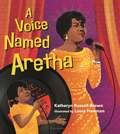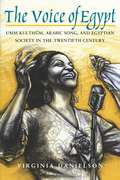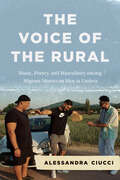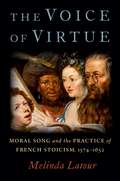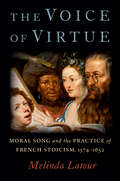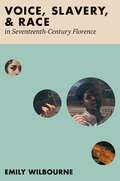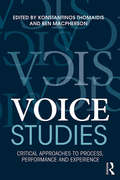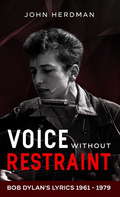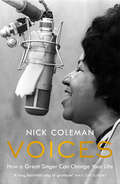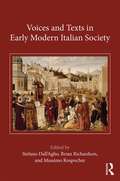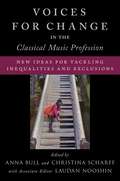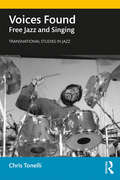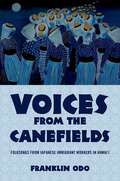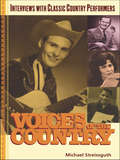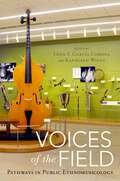- Table View
- List View
A Voice Named Aretha
by Katheryn Russell-BrownFrom acclaimed author and illustrator pairing comes a beautiful picture book biography about the Queen of Soul Aretha Franklin and how she fought for respect throughout her life.Aretha Franklin is the Queen of Soul, a legend. But before she became a star, she was a shy little girl with a voice so powerful it made people jump up, sway, and hum along. Raised in a house full of talking and singing, Aretha learned the values that would carry her through life--from her church choir in Detroit to stages across the world. When she moved to New York City to start her career, it took years of hard work before she had a hit song. In the turbulent 1960s, she sang about "Respect" and refused to perform before segregated audiences. The first woman inducted into the Rock & Roll Hall of Fame, Aretha always remembered who she was and where she came from. In this stirring biography of a true artistic and social icon, award-winning creators Katheryn Russell-Brown and Laura Freeman show young readers how Aretha's talent, intelligence, and perseverance made her a star who will shine on for generations to come.Acclaim for Little Melba and Her Big Trombone2015 NAACP Image Award Nominee Outstanding Literary Work--Children 2015 Coretta Scott King Illustrator Award Honor2015 ALA Notable Children's Book2015 Amelia Bloomer Project - Feminist Task Force2015 Orbis Pictus Award for Outstanding Nonfiction, Recommended Title
"The Voice of Egypt": Umm Kulthum, Arabic Song, and Egyptian Society in the Twentieth Century (Chicago Studies in Ethnomusicology #1997)
by Virginia DanielsonUmm Kulthum, the "voice of Egypt," was the most celebrated musical performer of the century in the Arab world. More than twenty years after her death, her devoted audience, drawn from all strata of Arab society, still numbers in the millions. Thanks to her skillful and pioneering use of mass media, her songs still permeate the international airwaves. In the first English-language biography of Umm Kulthum, Virginia Danielson chronicles the life of a major musical figure and the confluence of artistry, society, and creativity that characterized her remarkable career. Danielson examines the careful construction of Umm Kulthum's phenomenal popularity and success in a society that discouraged women from public performance. From childhood, her mentors honed her exceptional abilities to accord with Arab and Muslim practice, and as her stature grew, she remained attentive to her audience and the public reception of her work. Ultimately, she created from local precendents and traditions her own unique idiom and developed original song styles from both populist and neo-classical inspirations. These were enthusiastically received, heralded as crowning examples of a new, yet authentically Arab-Egyptian, culture. Danielson shows how Umm Kulthum's music and public personality helped form popular culture and contributed to the broader artistic, societal, and political forces that surrounded her. This richly descriptive account joins biography with social theory to explore the impact of the individual virtuoso on both music and society at large while telling the compelling story of one of the most famous musicians of all time. "She is born again every morning in the heart of 120 million beings. In the East a day without Umm Kulthum would have no color."—Omar Sharif
"The Voice of Egypt": Umm Kulthum, Arabic Song, and Egyptian Society in the Twentieth Century (Chicago Studies in Ethnomusicology #1997)
by Virginia DanielsonUmm Kulthum, the "voice of Egypt," was the most celebrated musical performer of the century in the Arab world. More than twenty years after her death, her devoted audience, drawn from all strata of Arab society, still numbers in the millions. Thanks to her skillful and pioneering use of mass media, her songs still permeate the international airwaves. In the first English-language biography of Umm Kulthum, Virginia Danielson chronicles the life of a major musical figure and the confluence of artistry, society, and creativity that characterized her remarkable career. Danielson examines the careful construction of Umm Kulthum's phenomenal popularity and success in a society that discouraged women from public performance. From childhood, her mentors honed her exceptional abilities to accord with Arab and Muslim practice, and as her stature grew, she remained attentive to her audience and the public reception of her work. Ultimately, she created from local precendents and traditions her own unique idiom and developed original song styles from both populist and neo-classical inspirations. These were enthusiastically received, heralded as crowning examples of a new, yet authentically Arab-Egyptian, culture. Danielson shows how Umm Kulthum's music and public personality helped form popular culture and contributed to the broader artistic, societal, and political forces that surrounded her. This richly descriptive account joins biography with social theory to explore the impact of the individual virtuoso on both music and society at large while telling the compelling story of one of the most famous musicians of all time. "She is born again every morning in the heart of 120 million beings. In the East a day without Umm Kulthum would have no color."—Omar Sharif
"The Voice of Egypt": Umm Kulthum, Arabic Song, and Egyptian Society in the Twentieth Century (Chicago Studies in Ethnomusicology #1997)
by Virginia DanielsonUmm Kulthum, the "voice of Egypt," was the most celebrated musical performer of the century in the Arab world. More than twenty years after her death, her devoted audience, drawn from all strata of Arab society, still numbers in the millions. Thanks to her skillful and pioneering use of mass media, her songs still permeate the international airwaves. In the first English-language biography of Umm Kulthum, Virginia Danielson chronicles the life of a major musical figure and the confluence of artistry, society, and creativity that characterized her remarkable career. Danielson examines the careful construction of Umm Kulthum's phenomenal popularity and success in a society that discouraged women from public performance. From childhood, her mentors honed her exceptional abilities to accord with Arab and Muslim practice, and as her stature grew, she remained attentive to her audience and the public reception of her work. Ultimately, she created from local precendents and traditions her own unique idiom and developed original song styles from both populist and neo-classical inspirations. These were enthusiastically received, heralded as crowning examples of a new, yet authentically Arab-Egyptian, culture. Danielson shows how Umm Kulthum's music and public personality helped form popular culture and contributed to the broader artistic, societal, and political forces that surrounded her. This richly descriptive account joins biography with social theory to explore the impact of the individual virtuoso on both music and society at large while telling the compelling story of one of the most famous musicians of all time. "She is born again every morning in the heart of 120 million beings. In the East a day without Umm Kulthum would have no color."—Omar Sharif
"The Voice of Egypt": Umm Kulthum, Arabic Song, and Egyptian Society in the Twentieth Century (Chicago Studies in Ethnomusicology #1997)
by Virginia DanielsonUmm Kulthum, the "voice of Egypt," was the most celebrated musical performer of the century in the Arab world. More than twenty years after her death, her devoted audience, drawn from all strata of Arab society, still numbers in the millions. Thanks to her skillful and pioneering use of mass media, her songs still permeate the international airwaves. In the first English-language biography of Umm Kulthum, Virginia Danielson chronicles the life of a major musical figure and the confluence of artistry, society, and creativity that characterized her remarkable career. Danielson examines the careful construction of Umm Kulthum's phenomenal popularity and success in a society that discouraged women from public performance. From childhood, her mentors honed her exceptional abilities to accord with Arab and Muslim practice, and as her stature grew, she remained attentive to her audience and the public reception of her work. Ultimately, she created from local precendents and traditions her own unique idiom and developed original song styles from both populist and neo-classical inspirations. These were enthusiastically received, heralded as crowning examples of a new, yet authentically Arab-Egyptian, culture. Danielson shows how Umm Kulthum's music and public personality helped form popular culture and contributed to the broader artistic, societal, and political forces that surrounded her. This richly descriptive account joins biography with social theory to explore the impact of the individual virtuoso on both music and society at large while telling the compelling story of one of the most famous musicians of all time. "She is born again every morning in the heart of 120 million beings. In the East a day without Umm Kulthum would have no color."—Omar Sharif
The Voice of the Century: The Culture of Italian Bel Canto in Luisa Tetrazzini’s Recorded Interpretations
by Massimo ZicariThe fields of performance studies, empirical musicology, and the musicology of recordings have seen a tremendous development in recent years, shedding new light on the recent history of our performing tradition and conveying essential information to music practitioners, critics and audiences. This innovative work considers the notion of bel canto and the manner in which this vibrant tradition lives in the records of Luisa Tetrazzini (1871-1940), one of the most celebrated sopranos ever. Tetrazzini, whose discographic career includes about 120 recordings, belongs to that generation of inspirational performers who heralded the dawn of a new era of music appreciation, alongside such iconic figures as Enrico Caruso, Adelina Patti and Nellie Melba. Drawing on a vast body of scholarship and a number of contemporary reviews, Massimo Zicari establishes Tetrazzini’s role in the Italian operatic tradition and its much disputed set of performing conventions. His transcriptions of her recorded interpretations from Rossini, Donizetti, Bellini and Verdi will prove invaluable to singers and conductors interested in a tradition that goes back to legendary figures such as Jenny Lind and Maria Malibran. The author also discusses her voice quality and technique, tempo flexibility, her use of vibrato and portamento—features of musical performance that question several widely-held, normative views about aesthetics and interpretative tradition. The volume includes eighty-eight musical examples and its closing section consists of the vocal scores of thirteen operatic arias. The musical material (both examples and transcriptions) is entirely original. This unique approach seeks to combine an academic perspective with the making of the music, in the hope that the plea for originality may be enhanced by models from the past.
The Voice of the Rural: Music, Poetry, and Masculinity among Migrant Moroccan Men in Umbria (Chicago Studies in Ethnomusicology)
by Alessandra CiucciA moving portrait of the contemporary experiences of migrant Moroccan men. Umbria is known to most Americans for its picturesque rolling hills and medieval villages, but to the many migrant Moroccan men who travel there, Umbria is better known for the tobacco fields, construction sites, small industries, and the outdoor weekly markets where they work. Marginalized and far from their homes, these men turn to Moroccan traditions of music and poetry that evoke the countryside they have left— l-‘arubiya, or the rural. In this book, Alessandra Ciucci takes us inside the lives of Moroccan workers, unpacking the way they share a particular musical style of the rural to create a sense of home and belonging in a foreign and inhospitable nation. Along the way, she uncovers how this culture of belonging is not just the product of the struggles of migration, but also tied to the reclamation of a noble and virtuous masculine identity that is inaccessible to Moroccan migrants in Italy. The Voice of the Rural allows us to understand the contemporary experiences of migrant Moroccan men by examining their imagined relationship to the rural through sound, shedding new light on the urgent issues of migration and belonging.
The Voice of Virtue: Moral Song and the Practice of French Stoicism, 1574-1652
by Melinda LatourThe Voice of Virtue illuminates the musical practices at the heart of the Neostoic movement that spread across French lands during the Wars of Religion in the latter half of the sixteenth century. Guided by twin reparative traditions granting music and philosophy therapeutic power, composers and performers across the embattled Catholic and Protestant confessions turned to moral song as a means of repairing personal and collective virtue damaged by the ongoing conflict. Moral song collections enlarged interest in Stoic philosophy by circulating its ethical program to a broader audience through attractive paraphrases of Stoic maxims set to music. Even more importantly, this skillfully composed repertoire of polyphonic song offered a multi-sensory moral practice that would have resonated powerfully for those well-versed in the paradoxes of the Stoic tradition. Bringing together a repertoire of little-known music prints, a rich visual culture, and an impressive body of literary and philosophical sources, The Voice of Virtue not only illuminates the influence of Stoicism on music, but also reveals that we cannot fully understand Neostoicism as an intellectual or cultural movement without accounting for its vibrant musical sounds. Virtue, as voiced in these Stoic practices, proves to be both rational and fully invested in the sensory processes of the singing body.
The Voice of Virtue: Moral Song and the Practice of French Stoicism, 1574-1652
by Melinda LatourThe Voice of Virtue illuminates the musical practices at the heart of the Neostoic movement that spread across French lands during the Wars of Religion in the latter half of the sixteenth century. Guided by twin reparative traditions granting music and philosophy therapeutic power, composers and performers across the embattled Catholic and Protestant confessions turned to moral song as a means of repairing personal and collective virtue damaged by the ongoing conflict. Moral song collections enlarged interest in Stoic philosophy by circulating its ethical program to a broader audience through attractive paraphrases of Stoic maxims set to music. Even more importantly, this skillfully composed repertoire of polyphonic song offered a multi-sensory moral practice that would have resonated powerfully for those well-versed in the paradoxes of the Stoic tradition. Bringing together a repertoire of little-known music prints, a rich visual culture, and an impressive body of literary and philosophical sources, The Voice of Virtue not only illuminates the influence of Stoicism on music, but also reveals that we cannot fully understand Neostoicism as an intellectual or cultural movement without accounting for its vibrant musical sounds. Virtue, as voiced in these Stoic practices, proves to be both rational and fully invested in the sensory processes of the singing body.
Voice, Slavery, and Race in Seventeenth-Century Florence
by Emily WilbourneGrounded in new archival research documenting a significant presence of foreign and racially-marked individuals in Medici Florence, this book argues for the relevance of such individuals to the history of Western music and for the importance of sound-particularly musical and vocal sounds-to systems of racial and ethnic difference. Many of the individuals discussed in these pages were subject to enslavement or conditions of unfree labor; some labored at tasks that were explicitly musical or theatrical, while all intersected with sound and with practices of listening that afforded full personhood only to particular categories of people. Integrating historical detail alongside contemporary performances and musical conventions, this book makes the forceful claim that operatic musical techniques were-from their very inception-imbricated with racialized differences. Author Emily Wilbourne offers both a macro and micro approach to the content of this book. The first half of the volume draws upon a wide range of archival, theatrical and historical sources to articulate the theoretical interdependence of razza (lit. "race"), voice, and music in early modern Italy; the second half focuses on the life and work of a specific, racially-marked individual: the enslaved, Black, male soprano singer, Giovannino Buonaccorsi (fl.1651-1674). Voice, Slavery, and Race in Seventeenth-Century Florence reframes the place of racial difference in Western art music and provides a compelling pre-history to later racial formulations of the sonic.
Voice, Slavery, and Race in Seventeenth-Century Florence
by Emily WilbourneGrounded in new archival research documenting a significant presence of foreign and racially-marked individuals in Medici Florence, this book argues for the relevance of such individuals to the history of Western music and for the importance of sound-particularly musical and vocal sounds-to systems of racial and ethnic difference. Many of the individuals discussed in these pages were subject to enslavement or conditions of unfree labor; some labored at tasks that were explicitly musical or theatrical, while all intersected with sound and with practices of listening that afforded full personhood only to particular categories of people. Integrating historical detail alongside contemporary performances and musical conventions, this book makes the forceful claim that operatic musical techniques were-from their very inception-imbricated with racialized differences. Author Emily Wilbourne offers both a macro and micro approach to the content of this book. The first half of the volume draws upon a wide range of archival, theatrical and historical sources to articulate the theoretical interdependence of razza (lit. "race"), voice, and music in early modern Italy; the second half focuses on the life and work of a specific, racially-marked individual: the enslaved, Black, male soprano singer, Giovannino Buonaccorsi (fl.1651-1674). Voice, Slavery, and Race in Seventeenth-Century Florence reframes the place of racial difference in Western art music and provides a compelling pre-history to later racial formulations of the sonic.
Voice Studies: Critical Approaches to Process, Performance and Experience (Routledge Voice Studies)
by Konstantinos Thomaidis Ben MacphersonVoice Studies brings together leading international scholars and practitioners, to re-examine what voice is, what voice does, and what we mean by "voice studies" in the process and experience of performance. This dynamic and interdisciplinary publication draws on a broad range of approaches, from composing and voice teaching through to psychoanalysis and philosophy, including: voice training from the Alexander Technique to practice-as-research; operatic and extended voices in early baroque and contemporary underwater singing; voices across cultures, from site-specific choral performance in Kentish mines and Australian sound art, to the laments of Kraho Indians, Korean pansori and Javanese wayang; voice, embodiment and gender in Robertson’s 1798 production of Phantasmagoria, Cathy Berberian radio show, and Romeo Castellucci’s theatre; perceiving voice as a composer, listener, or as eavesdropper; voice, technology and mobile apps. With contributions spanning six continents, the volume considers the processes of teaching or writing for voice, the performance of voice in theatre, live art, music, and on recordings, and the experience of voice in acoustic perception and research. It concludes with a multifaceted series of short provocations that simply revisit the core question of the whole volume: what is voice studies?
Voice Studies: Critical Approaches to Process, Performance and Experience (Routledge Voice Studies)
by Konstantinos Thomaidis Ben MacphersonVoice Studies brings together leading international scholars and practitioners, to re-examine what voice is, what voice does, and what we mean by "voice studies" in the process and experience of performance. This dynamic and interdisciplinary publication draws on a broad range of approaches, from composing and voice teaching through to psychoanalysis and philosophy, including: voice training from the Alexander Technique to practice-as-research; operatic and extended voices in early baroque and contemporary underwater singing; voices across cultures, from site-specific choral performance in Kentish mines and Australian sound art, to the laments of Kraho Indians, Korean pansori and Javanese wayang; voice, embodiment and gender in Robertson’s 1798 production of Phantasmagoria, Cathy Berberian radio show, and Romeo Castellucci’s theatre; perceiving voice as a composer, listener, or as eavesdropper; voice, technology and mobile apps. With contributions spanning six continents, the volume considers the processes of teaching or writing for voice, the performance of voice in theatre, live art, music, and on recordings, and the experience of voice in acoustic perception and research. It concludes with a multifaceted series of short provocations that simply revisit the core question of the whole volume: what is voice studies?
Voice Without Restraint: Bob Dylan's Lyrics 1961 - 1979
by John HerdmanBob Dylan was awarded the Nobel Prize in Literature in June 2016, and seldom in recent years has it been more richly deserved.That a song writer’s lyrics should be regarded as literature was an idea at which many were surprised.Others have felt that to isolate the lyrics of a song from its musical context is unreal. Ultimately that is true: a song is an indefeasible whole, an inseparable marriage of words and music which achieves its overall emotional effect by that symbiosis and not otherwise.Yet it can also be said that the two components can be separately considered as two elements in the artist’s creative utterance, and discussed as such.The evidence of Dylan’s manuscripts supports the view that in writing his lyrics his way of going about things is not always widely different from that of a poet.Bob Dylan commented on the Nobel Prize in Literature which was awarded to him "for having created new poetic expressions within the great American song tradition": "When I first received this Nobel Prize for Literature, I got to wondering exactly how my songs related to literature. I wanted to reflect on it and see where the connection was."Voice Without Restraint, refers to and is from the song “I dreamed I saw St Augustine” on John Wesley Harding, and is a phrase chosen to evoke the full-blooded commitment to his artistic utterance which is the hallmark of Bob Dylan’s voice – in all senses.
Voices: How a Great Singer Can Change Your Life
by Nick ColemanFood. Shelter. Warmth. Love. Voices. Other people’s voices, singing – the fifth essential necessity of life.Nick Coleman’s new book is an exploration of what singing means and how it works. What does it do to us to listen hard and habitually to somebody else’s singing? And why is the singing of others so essential to human life? Why do we love it so? The book asks many other questions too. What was Roy Orbison’s problem? Who does Joni Mitchell think she is? Why did Jagger and Lennon sing like that (and not like this)? What did Aretha Franklin do to deserve the title ‘Queen of Soul’? For that matter, what is 'soul’? What is the point of crooning? What does it say about you if Frank Sinatra leaves you cold? Billie, Janis, Amy: must the voices of anguish always dissolve into spectacle? The history of post-war popular music is traditionally told sociologically or in terms of musicological influence and innovation in style. Voices takes a different tack. In ten discrete but cohering essays Coleman tackles the arc of that history as if it were an emotional experience with real psychological consequences – as chaotic, random, challenging and unpredictable as life itself. It is the story of what it is to listen and learn. Above all, it is a story of what it means to feel.
Voices and Texts in Early Modern Italian Society
by Stefano Dall’Aglio Brian Richardson Massimo RospocherThis book studies the uses of orality in Italian society, across all classes, from the fifteenth to the seventeenth century, with an emphasis on the interrelationships between oral communication and the written word. The Introduction provides an overview of the topic as a whole and links the chapters together. Part 1 concerns public life in the states of northern, central, and southern Italy. The chapters examine a range of performances that used the spoken word or song: concerted shouts that expressed the feelings of the lower classes and were then recorded in writing; the proclamation of state policy by town criers; songs that gave news of executions; the exercise of power relations in society as recorded in trial records; and diplomatic orations and interactions. Part 2 centres on private entertainments. It considers the practices of the performance of poetry sung in social gatherings and on stage with and without improvisation; the extent to which lyric poets anticipated the singing of their verse and collaborated with composers; performances of comedies given as dinner entertainments for the governing body of republican Florence; and a reading of a prose work in a house in Venice, subsequently made famous through a printed account. Part 3 concerns collective religious practices. Its chapters study sermons in their own right and in relation to written texts, the battle to control spaces for public performance by civic and religious authorities, and singing texts in sacred spaces.
Voices and Texts in Early Modern Italian Society
by Stefano Dall'Aglio Brian Richardson Massimo RospocherThis book studies the uses of orality in Italian society, across all classes, from the fifteenth to the seventeenth century, with an emphasis on the interrelationships between oral communication and the written word. The Introduction provides an overview of the topic as a whole and links the chapters together. Part 1 concerns public life in the states of northern, central, and southern Italy. The chapters examine a range of performances that used the spoken word or song: concerted shouts that expressed the feelings of the lower classes and were then recorded in writing; the proclamation of state policy by town criers; songs that gave news of executions; the exercise of power relations in society as recorded in trial records; and diplomatic orations and interactions. Part 2 centres on private entertainments. It considers the practices of the performance of poetry sung in social gatherings and on stage with and without improvisation; the extent to which lyric poets anticipated the singing of their verse and collaborated with composers; performances of comedies given as dinner entertainments for the governing body of republican Florence; and a reading of a prose work in a house in Venice, subsequently made famous through a printed account. Part 3 concerns collective religious practices. Its chapters study sermons in their own right and in relation to written texts, the battle to control spaces for public performance by civic and religious authorities, and singing texts in sacred spaces.
Voices for Change in the Classical Music Profession: New Ideas for Tackling Inequalities and Exclusions
by Anna Bull Christina Scharff Laudan NooshinHow is the classical music industry responding to the challenges of #MeToo, Black Lives Matter, and other social justice movements? Is increasing attention to equity and diversity in the classical music profession over recent years leading to systemic change? In this book, scholars, activists and musicians from countries across Europe and North America analyze inequalities in the classical music profession and introduce strategies for making change. Exploring racism, class and gender inequalities, disability representation, "authenticity", changing the canon, and neoliberalism, the book brings together analyses from academics alongside contributions from musicians and industry leaders working in the classical music industry who reflect on issues of diversity and share insights and best practices. Themes of the book include institutional legacies and possibilities for change; racial, classed and gendered inequalities and marginalised voices; and strategies for activism, whether reflective practices, informal networks, or larger organisations leading change. The book also discusses questions such as whether musical change is necessary for social change in classical music, and how activists can acknowledge structural inequalities whilst holding on to the possibility of change. Opening up the interdisciplinary field of "classical music studies," this book lays the groundwork for empirically-founded, theoretically-informed, and practice-based approaches to tackling inequalities in the classical music profession. As such, it will be a significant point of reference for musicians, students, classical music administrators, policy-makers, teachers, and academics -- and anyone else who wants to make classical music more inclusive.
Voices for Change in the Classical Music Profession: New Ideas for Tackling Inequalities and Exclusions
by Anna Bull Christina Scharff Laudan NooshinHow is the classical music industry responding to the challenges of #MeToo, Black Lives Matter, and other social justice movements? Is increasing attention to equity and diversity in the classical music profession over recent years leading to systemic change? In this book, scholars, activists and musicians from countries across Europe and North America analyze inequalities in the classical music profession and introduce strategies for making change. Exploring racism, class and gender inequalities, disability representation, "authenticity", changing the canon, and neoliberalism, the book brings together analyses from academics alongside contributions from musicians and industry leaders working in the classical music industry who reflect on issues of diversity and share insights and best practices. Themes of the book include institutional legacies and possibilities for change; racial, classed and gendered inequalities and marginalised voices; and strategies for activism, whether reflective practices, informal networks, or larger organisations leading change. The book also discusses questions such as whether musical change is necessary for social change in classical music, and how activists can acknowledge structural inequalities whilst holding on to the possibility of change. Opening up the interdisciplinary field of "classical music studies," this book lays the groundwork for empirically-founded, theoretically-informed, and practice-based approaches to tackling inequalities in the classical music profession. As such, it will be a significant point of reference for musicians, students, classical music administrators, policy-makers, teachers, and academics -- and anyone else who wants to make classical music more inclusive.
Voices Found: Free Jazz and Singing
by Chris TonelliVoices Found: Free Jazz and Singing contributes to a wave of voice studies scholarship with the first book-length study of free jazz voice. It pieces together a history of free jazz voice that spans from sound poetry and scat in the 1950s to the more recent wave of free jazz choirs. The author traces the developments and offers a theory, derived from interviews with many of the most important singers in the history of free jazz voice, of how listeners have experienced and evaluated the often unconventional vocal sounds these vocalists employed. This theory explains that even audiences willing to enjoy harsh sounds from saxophones or guitars often resist when voices make sounds that audiences understand as not-human. Experimental poetry and scat were combined and transformed in free jazz spaces in the 1960s and 1970s by vocalists like Yoko Ono (in solo work and her work with Ornette Coleman and John Stevens), Jeanne Lee (in her solo work and her work with Archie Shepp and Gunter Hampel), Leon Thomas (in his solo work as well as his work with Pharoah Sanders and Carlos Santana), and Phil Minton and Maggie Nicols (who devoted much of their energy to creating unaccompanied free jazz vocal music). By studying free jazz voice we can learn important lessons about what we expect from the voice and what happens when those expectations are violated. This book doesn't only trace histories of free jazz voice, it makes an attempt to understand why this story hasn't been told before, with an impressive breadth of scope in terms of the artists covered, drawing on research from the US, Canada, Wales, Scotland, France, The Netherlands, and Japan.
Voices Found: Free Jazz and Singing
by Chris TonelliVoices Found: Free Jazz and Singing contributes to a wave of voice studies scholarship with the first book-length study of free jazz voice. It pieces together a history of free jazz voice that spans from sound poetry and scat in the 1950s to the more recent wave of free jazz choirs. The author traces the developments and offers a theory, derived from interviews with many of the most important singers in the history of free jazz voice, of how listeners have experienced and evaluated the often unconventional vocal sounds these vocalists employed. This theory explains that even audiences willing to enjoy harsh sounds from saxophones or guitars often resist when voices make sounds that audiences understand as not-human. Experimental poetry and scat were combined and transformed in free jazz spaces in the 1960s and 1970s by vocalists like Yoko Ono (in solo work and her work with Ornette Coleman and John Stevens), Jeanne Lee (in her solo work and her work with Archie Shepp and Gunter Hampel), Leon Thomas (in his solo work as well as his work with Pharoah Sanders and Carlos Santana), and Phil Minton and Maggie Nicols (who devoted much of their energy to creating unaccompanied free jazz vocal music). By studying free jazz voice we can learn important lessons about what we expect from the voice and what happens when those expectations are violated. This book doesn't only trace histories of free jazz voice, it makes an attempt to understand why this story hasn't been told before, with an impressive breadth of scope in terms of the artists covered, drawing on research from the US, Canada, Wales, Scotland, France, The Netherlands, and Japan.
Voices from the Canefields: Folksongs from Japanese Immigrant Workers in Hawai'i (American Musicspheres)
by Franklin OdoFolk songs are short stories from the souls of common people. Some, like Mexican corridos or Scottish ballads, reworked in the Appalachias, are stories of tragic or heroic episodes. Others, like the African American blues, reach from a difficult present back into slavery and forward into a troubled future. Japanese workers in Hawaii's plantations created their own versions, in form more akin to their traditional tanka or haiku poetry. These holehole bushi describe the experiences of one particular group caught in the global movements of capital, empire, and labor during the late nineteenth and early twentieth centuries. In Voices from the Canefields author Franklin Odo situates over two hundred of these songs, in translation, in a hitherto largely unexplored historical context. Japanese laborers quickly comprised the majority of Hawaiian sugar plantation workers after their large-scale importation as contract workers in 1885. Their folk songs provide good examples of the intersection between local work/life and the global connection which the workers clearly perceived after arriving. While many are songs of lamentation, others reflect a rapid adaptation to a new society in which other ethnic groups were arranged in untidy hierarchical order - the origins of a unique multicultural social order dominated by an oligarchy of white planters. Odo also recognizes the influence of the immigrants' rapidly modernizing homeland societies through his exploration of the "cultural baggage" brought by immigrants and some of their dangerous notions of cultural superiority. Japanese immigrants were thus simultaneously the targets of intense racial and class vitriol even as they took comfort in the expanding Japanese empire. Engagingly written and drawing on a multitude of sources including family histories, newspapers, oral histories, the expressed perspectives of women in this immigrant society, and accounts from the prolific Japanese language press into the narrative, Voices from the Canefields will speak not only to scholars of ethnomusicology, migration history, and ethnic/racial movements, but also to a general audience of Japanese Americans seeking connections to their cultural past and the experiences of their most recently past generations.
Voices of the Country: Interviews with Classic Country Performers
by Michael Streissguth"Voices of the Country" presents interviews with innovative musicians, producers, and songwriters who shaped the last fifty years of country music. From Eddy Arnold's new, smoother approach to song delivery to Loretta Lynn's take-no-prisoners feminism, these people opened new vistas in country music - and American culture. Streissguth is a sensitive and knowledgeable interviewer: he gets beyond the standard publicity tales to the heart of the real voice - and real experiences - of these important figures.
Voices of the Country: Interviews with Classic Country Performers
by Michael Streissguth"Voices of the Country" presents interviews with innovative musicians, producers, and songwriters who shaped the last fifty years of country music. From Eddy Arnold's new, smoother approach to song delivery to Loretta Lynn's take-no-prisoners feminism, these people opened new vistas in country music - and American culture. Streissguth is a sensitive and knowledgeable interviewer: he gets beyond the standard publicity tales to the heart of the real voice - and real experiences - of these important figures.
Voices of the Field: Pathways in Public Ethnomusicology
by León F. García Corona and Kathleen WiensEthnomusicologists face complex and challenging professional landscapes for which graduate studies in the field do not fully prepare them. The essays in Voices of the Field: Pathways in Public Ethnomusicology, edited by León F. García Corona and Kathleen Wiens, provide a reflection on the challenges, opportunities, and often overlooked importance of public ethnomusicology. These essays capture years of experience of fourteen scholars who have simultaneously navigated the worlds within and outside of academia, sharing valuable lessons often missing in ethnomusicological training. Power and organizational structures, marketing, content management and production are among the themes explored as an extension and re-evaluation of what constitutes the field of/in ethnomusicology. Many of the authors in this volume share how to successfully acquire funding for a project, while others illustrate how to navigate non-academic workplaces, and yet others share perspectives on reconciling business-like mindsets with humanistic goals. Grounded in case studies in multiple institutional and geographical locations, authors advocate for the importance and relevance of ethnomusicology in our society at large.
